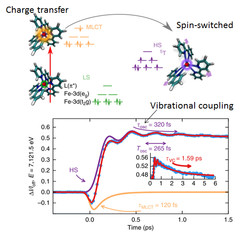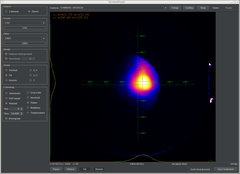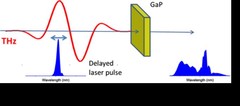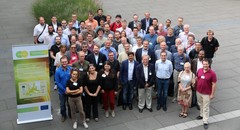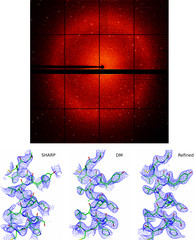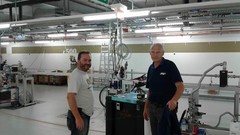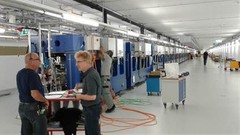News & Scientific Highlights
Scientists get first direct look at how electrons ‘dance’ with vibrating atoms
Research experience from California's X-ray free-electron laser benefits SwissFEL. It's the camera that allows researchers to make extremely rapid processes visible: the X-ray free-electron laser. Currently, however, only three sites worldwide—in the US, Japan and South Korea—have facilities capable of carrying out such measurements. Two current articles in Science and Nature Communications co-authored by researchers now at the Paul Scherrer Institute PSI exemplify the kind of outstanding scientific work that can be carried out at such facilities, enabling new insights into the mechanisms of superconductors and magnetic switching in molecules. The measurements were conducted at the Linac Coherent Light Source (LCLS) free-electron laser in California. Press release PSI / Press release SLAC
Observing switching of Molecules using Free Electron Lasers
Free electron lasers (FELs) like SwissFEL help scientists to understand the mechanisms that switch properties of materials which are the basis for functions in electronics, solar cells, chemistry and biology. By using ultrashort X-ray pulses it becomes possible to visualize the ultrafast rearrangements of electrons and atoms that enable the properties to switch in molecules or crystals. An international consortium of researchers lead by Paul Scherrer Institute, Université de Rennes, and SLAC National Laboratory has now visualized the entire cascade of processes that lead to a change of the magnetic moment of electrons in a molecule within one trillionth of a second (10-12 s = 1 picosecond), using the FEL at Stanford, California (LCLS).
First lasing at a wavelength of 4.1 nm
The electron beam energy of SwissFEL was recently increased to above 900 MeV by successfully bringing two new accelerating modules into operation. This allowed SwissFEL to produce laser radiation for the first time in the soft x-ray regime with a photon wavelength of 4.1 nm. During the next months, the electron beam energy will be progressively further increased with the goal of enabling first user experiments at a wavelength of around 0.5 nm towards the end of this year.
SwissFEL First Lasing
On Friday December 2nd at 1am SwissFEL observed for the first time FEL lasing in the undulator line. The lasing was achieved with a commission beam of low intensity, repetition rate and energy, i.e. 100pC/bunch, 1Hz and 377MeV. The 12 undulators were set to a K value of 1.2. The resulting wavelength computed from beam energy and undulator K value is 24nm. The FEL signal was observed with a Si-diode detector. The spontaneous radiation signal with uncompressed electron beam increased by a large factor when the beam was compressed from 10ps to about 1ps at constant charge and electron beam energy. By opening the undulator gaps a first FEL gain curve was measured.
Extreme optical and electronic nonlinearities in GaP induced by an ultrastrong Terahertz field
Researchers from the SwissFEL laser group have succeeded in using intense Terahertz radiation to dramatically change the optical properties of a semiconductor on a sub-cycle timescale. In their experiment the material Gallium Phosphide (GaP) was illuminated by an extremely strong THz electric field with up to 50 MV/cm in strength.
EUCALL finishes first year, bearing new technologies
The European Cluster of Advanced Laser Light sources (EUCALL), a European Union-funded project that aims to foster links between accelerator- and laser-driven X-ray facilities, has completed the first year of its three year project period. The project successfully met all twenty of its milestones for the year, producing a new open-source tool for experiment simulations and developing specifications for several pieces of new scientific equipment.
First protein structure solved using the JUNGFRAU detector
JUNGFRAU is a charge-integrating, two-dimensional pixel detector developed at the Paul Scherrer Institut for use at free-electron lasers, in particular SwissFEL, and synchrotron light sources. On the 10th October, the first protein crystallography experiment using the JUNGFRAU detector, was performed at the beamline X06SA (PXI) of the Swiss Light Source by the members of the Protein Crystallography and Detectors groups at PSI.
Completion of the vacuum pipes assembly from injector to front end
On Monday October the 10th the last piece of the vacuum tube was mounted and pumped down. The about 500 m long vacuum chamber from the end of the injector to the photonics front end is now under vacuum. The only missing junction at z=119m between the already operated injector and the rest of SwissFEL will be mounted shortly before the delivery of the operation permit.
Last undulator placed in SwissFEL tunnel
On the 6th of October the last undulator for the ARAMIS beamline was placed into the SwissFEL tunnel. Thanks to the efficiency and motivation of the different groups involved with undulator preparation, all 12 undulators were assembled, measured and installed in the tunnel between the 2nd of February 2016 and the 6th of October 2016.

